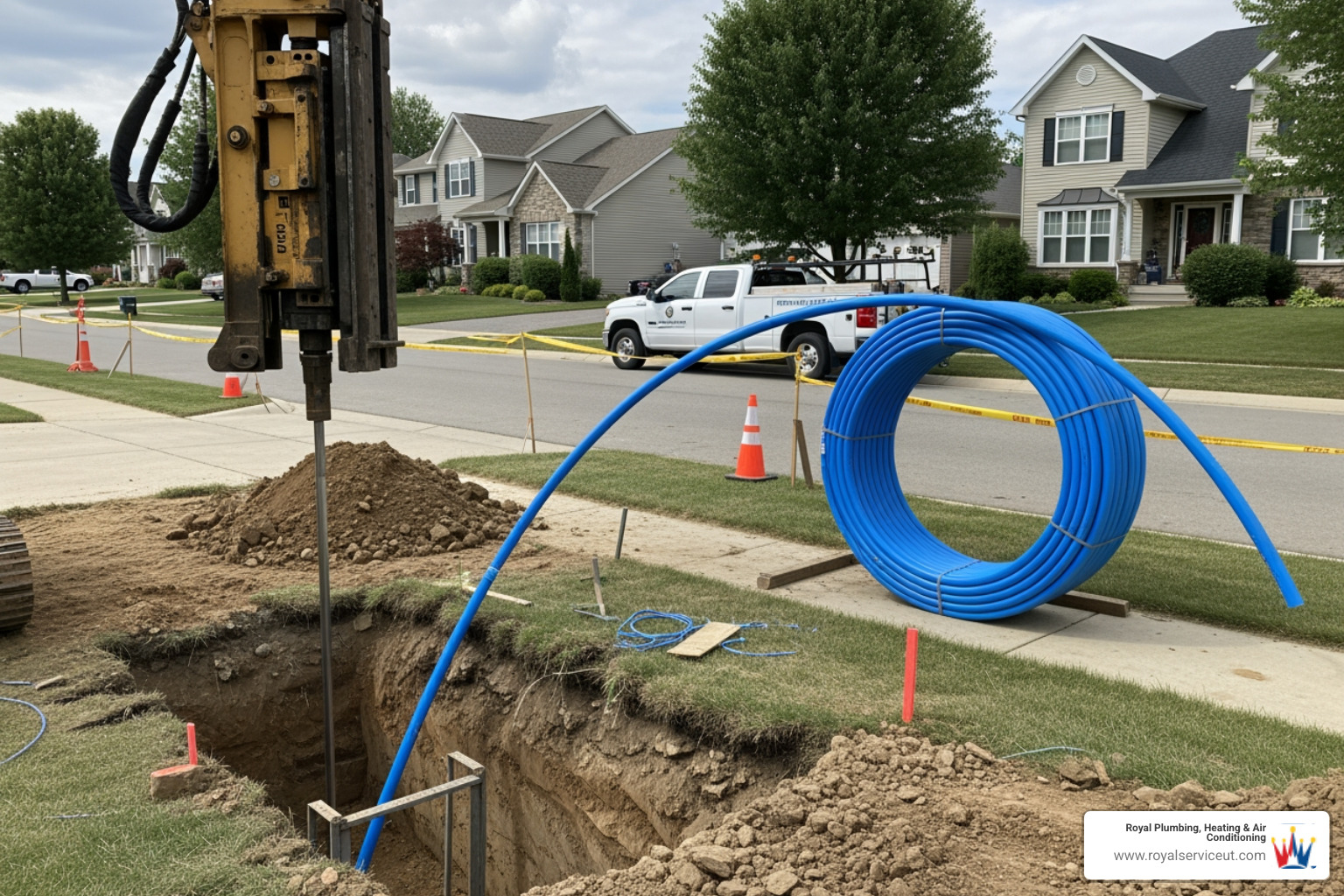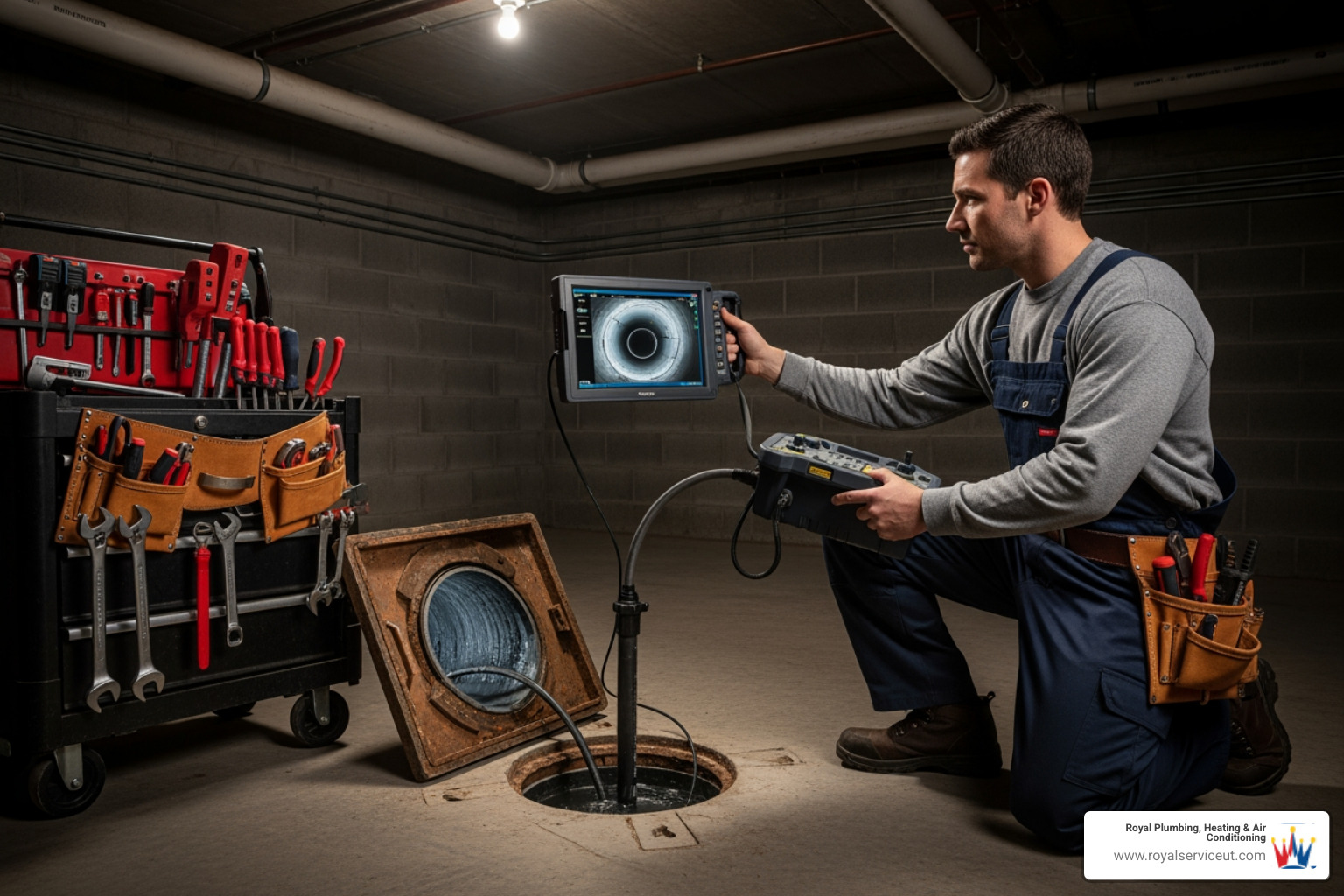If you own a home built between 1945 and 1972 in Northern Utah, your sewer line might be made from Orangeburg pipe—a material popular after World War II that has a serious flaw: it wasn't built to last. Made from wood pulp and coal tar pitch, this pipe absorbs moisture, weakens over time, and often collapses after about 50 years. Homes with this type of plumbing are living on borrowed time. When these pipes fail, you're not just dealing with slow drains or bad smells—you're facing potential sewage backups, yard damage, and an urgent replacement project.
Understanding the factors that determine the scope of an Orangeburg pipe replacement helps homeowners plan ahead and avoid emergency situations. The project's complexity can vary significantly based on factors like pipe length, depth, accessibility, and the chosen replacement method. This guide breaks down what you need to know about replacement options, warning signs, and the variables that influence your project.

Orangeburg pipe was a common sewer line material used from the mid-1940s to the early 1970s, largely due to post-WWII material shortages. It was an available alternative to cast iron, making it a popular choice for new home construction in areas like Northern Utah.
Unlike modern durable pipes, Orangeburg is made from layers of wood pulp fibers compressed with an adhesive and impregnated with liquefied coal tar pitch. This composition is its biggest downfall. Because it's made of organic materials, Orangeburg pipe absorbs moisture from wastewater and groundwater. This causes the pipe to soften, lose its structural integrity, and eventually deform or collapse, which is why it almost always requires replacement when problems arise.
Orangeburg pipe was designed to last about 50 years under ideal conditions, but many systems fail much sooner, especially in Northern Utah's climate where freeze-thaw cycles add stress. As the pipe softens, it can "oval" or flatten, restricting flow and causing frequent clogs. The softened material is also highly susceptible to pressure from soil, which can cause it to collapse.
Furthermore, the fibrous material is an easy target for tree roots seeking moisture. Once roots penetrate the pipe, they create blockages and accelerate its breakdown. Compared to modern PVC or HDPE pipes that can last 100 years or more, Orangeburg's 50-year lifespan is remarkably short. If your home was built between 1945 and 1972, your pipes are likely at or past their intended service life.
If your home falls within that construction window, there's a significant chance you have Orangeburg pipes. The most definitive way to know for sure and to assess its condition is through a professional sewer camera inspection. This allows a technician to visually inspect the interior of your sewer line, identify the material, and check for signs of deterioration like ovaling, delamination, or root intrusion. An inspection is a crucial first step in understanding your risk and planning for a potential replacement.
Orangeburg pipe rarely fails without warning. Recognizing the distress signals early can help you address the issue before it becomes a major emergency. When considering a project like an Orangeburg pipe replacement, catching the problem early gives you more control over the situation and helps avoid a crisis like a sewage backup on a holiday weekend.

The first signs of trouble often appear inside your home. Be on the lookout for:
Your yard can also reveal clues about the health of your sewer line:
If you notice any combination of these symptoms, it's time for a professional inspection. Addressing these signs promptly gives you more options for replacement and helps you plan accordingly.
When it's time to replace your Orangeburg pipe, you have two main approaches: traditional excavation (trenching) and modern trenchless solutions. The method you choose will affect the project timeline and the level of disruption to your property.
Here's a quick comparison:
| Feature | Traditional Trenching | Trenchless Methods (Pipe Bursting/CIPP) |
|---|---|---|
| Yard Disruption | Extensive (full trench dug) | Minimal (small access points) |
| Project Time | Longer (days to over a week) | Shorter (often a day or less) |
| Restoration Needs | High (landscaping, concrete, etc.) | Low (minor patch-up) |
| Applicability | Almost all situations | Best for pipes that are not fully collapsed |
| Pipe Removal | Old pipe is fully removed | Old pipe is burst apart or lined |
This classic method involves digging a trench along the entire length of the sewer line, from your home to the municipal main. After locating the line, we excavate to expose the old pipe. This can be disruptive if the line runs under landscaping, patios, or driveways. Once exposed, the old Orangeburg pipe is removed and replaced with a new, durable pipe like PVC or HDPE. After a thorough inspection, the trench is backfilled. The final step is restoring any disturbed surfaces, such as your lawn or driveway. The main advantage of trenching is that it works in nearly any situation, especially when a pipe is severely collapsed.
For homeowners who want to preserve their landscaping, driveways, and mature trees, trenchless technology offers a far less invasive alternative. These methods are particularly appealing as they avoid the extensive property damage and subsequent restoration needs associated with traditional digging.

Trenchless methods are not always possible. If the existing pipe is fully collapsed or has severe offsets, traditional trenching may be the only viable option. A professional camera inspection is essential to determine the condition of your pipe and recommend the most effective method for your property.
No two Orangeburg pipe replacement projects are exactly alike. The final scope and complexity depend on a unique combination of factors specific to your home and property in Northern Utah. Understanding these variables will help you have an informed discussion with your plumbing professional.

The choice between traditional trenching and trenchless technology is the most significant factor influencing the project's overall scope.
Traditional trenching involves extensive excavation. While the pipe installation itself is straightforward, the project must also account for the labor and equipment needed to dig the trench and, crucially, to restore everything that was disturbed. This can include replanting lawns, repairing gardens, and repaving driveways or patios.
Trenchless methods are less disruptive to your property. While they require specialized equipment and skilled technicians, they eliminate the need for large-scale excavation and restoration. For many homeowners, preserving their landscape and hardscaping is a major priority.
Beyond the method, several other factors will shape your sewer line replacement:
Pipe Length and Depth: A longer sewer line naturally requires more materials and labor. Depth is also a key factor, especially in Northern Utah, where lines must be buried below the frost line. Deeper pipes require more extensive excavation and safety measures.
Location and Accessibility: A sewer line running under an open lawn is much simpler to access than one located beneath a deck, a concrete driveway, or the root system of a large tree. Each obstacle adds complexity and requires special techniques to work around.
Local Permits and Regulations: All sewer line replacements require permits to ensure the work complies with local municipal codes. These regulations vary by city, and the permitting process is a standard part of any professional project.
Choice of New Pipe Material: Modern options like PVC (polyvinyl chloride) and HDPE (high-density polyethylene) are durable, long-lasting, and resistant to root intrusion. Your plumbing professional can explain the benefits of each material and help you select the best fit for your home and the chosen replacement method.
A thorough, professional assessment is the essential first step. This begins with a sewer camera inspection, which allows a technician to see the exact condition of your pipe, measure its length, and identify any collapses, blockages, or root intrusion. This diagnostic step provides the critical information needed to recommend the most effective and appropriate solution for your home. A clear scope of work should be provided, detailing the recommended method, materials, and all steps involved in the project.
Deciding to replace your Orangeburg pipe is a significant but smart decision for your Northern Utah home. Understanding the process and the lasting benefits can provide peace of mind.
A professional replacement follows a clear, organized process to minimize disruption.
Replacing your Orangeburg pipe is about protecting your home and investment for decades.
If you own a home built between 1945 and 1972 in Northern Utah, addressing your Orangeburg pipe is about protecting one of your most valuable investments. This material was never meant to last forever, and after decades in the ground, its service life is coming to an end.
The good news is that you can be proactive. By recognizing the warning signs—from slow drains to soggy spots in your yard—you can take action before a minor issue becomes a crisis. A planned replacement allows you to choose the best method for your property, rather than scrambling during an emergency.
Replacing your Orangeburg pipe eliminates the worry of backups, prevents serious property damage, and increases your home's value. Most importantly, it provides the peace of mind that comes with a reliable, modern sewer system built to last for another century.
At Royal Plumbing, Heating & Air Conditioning, we've helped countless Northern Utah homeowners steer this exact situation. We understand that it's a significant undertaking, but it's one of the smartest improvements you can make for your home's long-term health. We are here to make the process as straightforward as possible with clear explanations and reliable service.
Don't wait for your old pipes to fail. Contact us for your sewer line repair needs today, and let's talk about giving your home the royal treatment it deserves—starting from the ground up.
Find answers to frequently asked questions about our services.
By reading this blog post, you will gain valuable insights and knowledge that can help you in your daily life.
The purpose of this blog post is to inform and educate readers about a specific topic, providing them with useful information and tips.
The target audience for this blog post includes individuals who are interested in learning more about the topic and seeking practical advice.
You can apply the knowledge and tips shared in this blog post to your own life by implementing them in your daily routine.
The benefits of reading this blog post include gaining new perspectives, acquiring practical skills, and enhancing your overall knowledge on the topic.
Absolutely! Feel free to share this blog post with your friends, family, or anyone who might find it helpful or interesting.
Yes, the information provided in this blog post is reliable and based on credible sources. We strive to ensure the accuracy and quality of the content we share.
The benefits of reading this blog post include gaining new perspectives, acquiring practical skills, and enhancing your overall knowledge on the topic.
If you have more questions related to the blog post topic, please don't hesitate to contact our team. We're here to help!
We value your feedback! If you have any suggestions, comments, or feedback regarding this blog post, please let us know. Your input is important to us.
Trust our team of dedicated professionals for all your HVAC and plumbing needs.